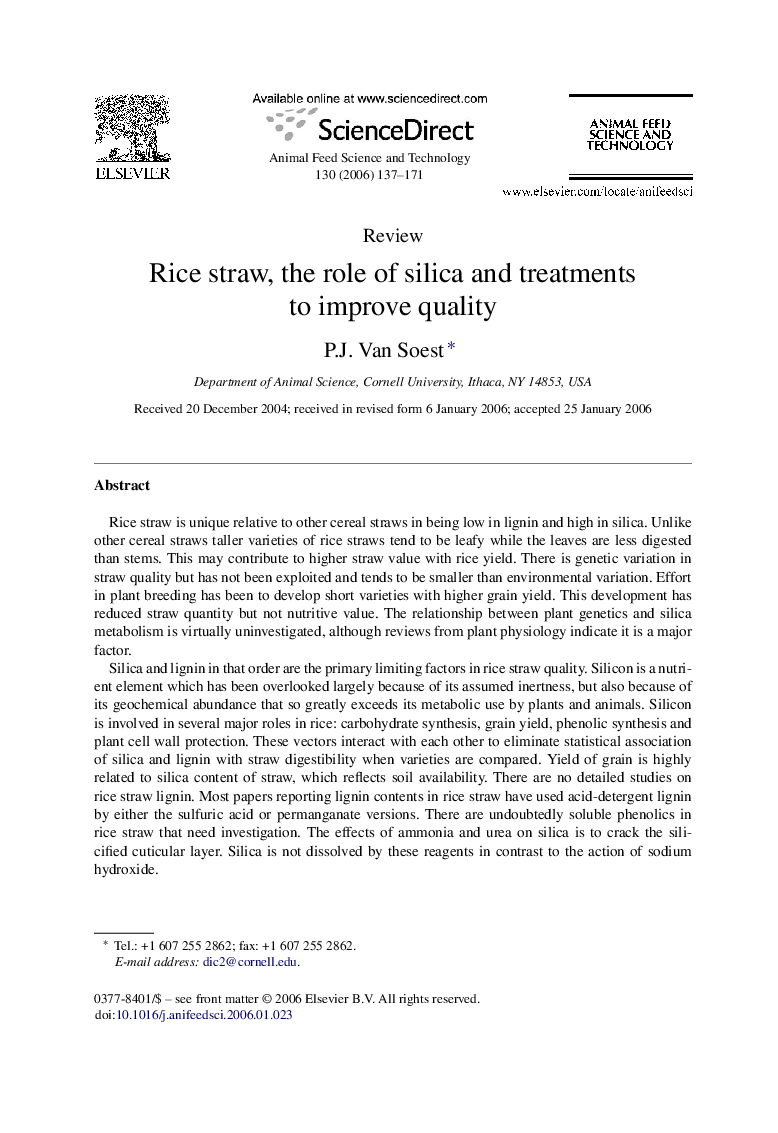| کد مقاله | کد نشریه | سال انتشار | مقاله انگلیسی | نسخه تمام متن |
|---|---|---|---|---|
| 2421109 | 1552494 | 2006 | 35 صفحه PDF | دانلود رایگان |

Rice straw is unique relative to other cereal straws in being low in lignin and high in silica. Unlike other cereal straws taller varieties of rice straws tend to be leafy while the leaves are less digested than stems. This may contribute to higher straw value with rice yield. There is genetic variation in straw quality but has not been exploited and tends to be smaller than environmental variation. Effort in plant breeding has been to develop short varieties with higher grain yield. This development has reduced straw quantity but not nutritive value. The relationship between plant genetics and silica metabolism is virtually uninvestigated, although reviews from plant physiology indicate it is a major factor.Silica and lignin in that order are the primary limiting factors in rice straw quality. Silicon is a nutrient element which has been overlooked largely because of its assumed inertness, but also because of its geochemical abundance that so greatly exceeds its metabolic use by plants and animals. Silicon is involved in several major roles in rice: carbohydrate synthesis, grain yield, phenolic synthesis and plant cell wall protection. These vectors interact with each other to eliminate statistical association of silica and lignin with straw digestibility when varieties are compared. Yield of grain is highly related to silica content of straw, which reflects soil availability. There are no detailed studies on rice straw lignin. Most papers reporting lignin contents in rice straw have used acid-detergent lignin by either the sulfuric acid or permanganate versions. There are undoubtedly soluble phenolics in rice straw that need investigation. The effects of ammonia and urea on silica is to crack the silicified cuticular layer. Silica is not dissolved by these reagents in contrast to the action of sodium hydroxide.Treatments on rice straw follow those applied to other lignified materials. In order of frequency of reports, urea followed by ammonia with comparatively fewer papers on sodium hydroxide, steam and pressure treatments or exploded by pressure release, and only one or two papers on acid treatments and white rot fungi. There are reports on animal supplementation and a few growth studies with young animals. Field surveys in India and the southeast Asian countries only report the use of urea, although it appears less efficient than ammonia. Farmer acceptance is related to their perceptions on costs, labor, equipment, health, safety, i.e. the exposure to ammonia vapor, economic and other social factors. The various papers reporting treatments have used animal digestion trials; a variety of in sacco, in vitro digestions with rumen organisms or cellulase, some in combination with pepsin digestion or neutral-detergent extraction. Gas production from in vitro rumen fermentation has also been used. Results are expressed mainly on dry matter basis and fewer reports on organic matter. Results are difficult to compare and standardization of procedures is badly needed. However, most treatments with ammonia and urea show some increase in digestibility and intake where measured in in vivo trials. In vitro and in sacco evaluations tend to overestimate improvement in digestibility.
Journal: Animal Feed Science and Technology - Volume 130, Issues 3–4, 1 November 2006, Pages 137–171